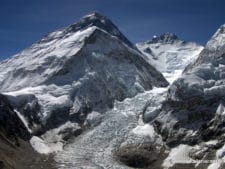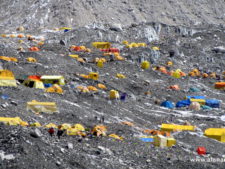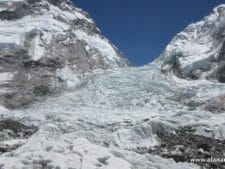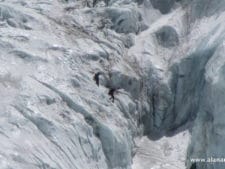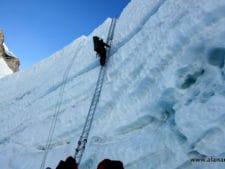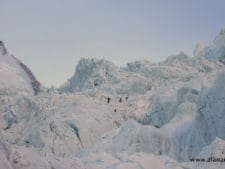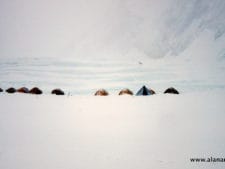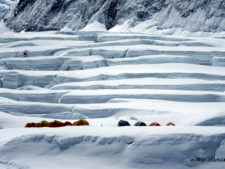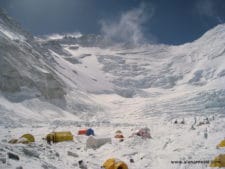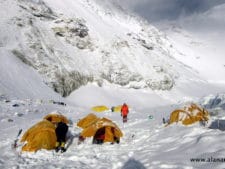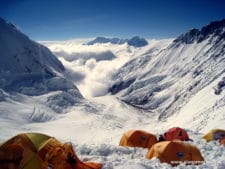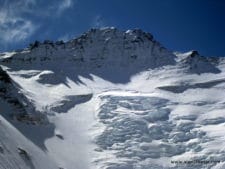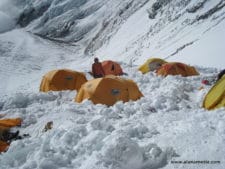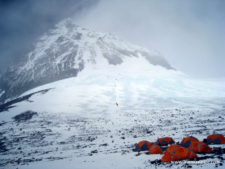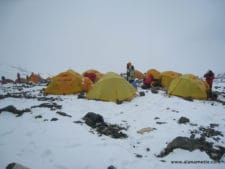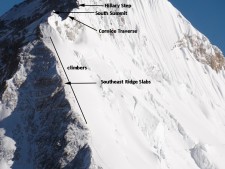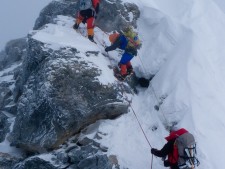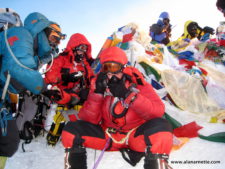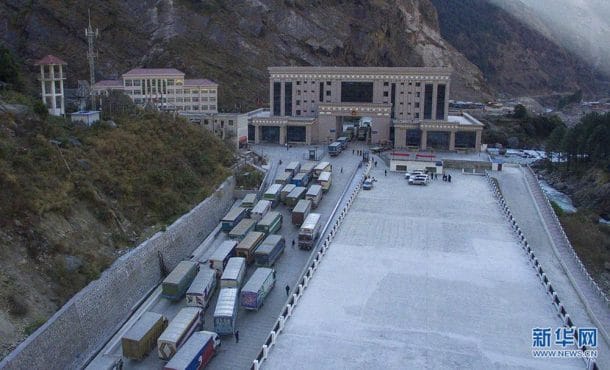Welcome to the kick-off for my Everest 2020 coverage! I have already posted a few articles on 2020 and am actively covering the current winter Everest attempts so let me officially welcome you.
This will be my 19th season of all-things Everest: 13 times providing coverage, another 4 seasons of actually climbing on Everest and two years attempting Lhotse.
I did similar coverage for the 2004, 2005, 2006, 2007, 2009, 2010, 2012, 2013, 2014, 2015, 2016, 2017, 2018, 2019 and now 2020 seasons. I summited Everest on May 21, 2011, and have attempted Everest three other times – 2002, 2003, 2008 and Lhotse in 2015 and 2016.
If you are one of my 2 million regular readers, hello again, if you are new, welcome!
My goal is to provide insight and analysis of what is going on up there with no favorites or agendas. I use sources directly from the mountain, public information plus my own experiences to write my posts.
Usually, I post once a day as the season gets started in early April and ramp-up to almost hourly coverage during the intense summit pushes in mid to late May. I spend several hours a day to create these updates. You can sign up for (and cancel) notifications on the lower right sidebar or check the site frequently.
Why do I do this? Well, one word: Alzheimer’s. I lost my mom, Ida, and four aunts to this disease and it changed my life forever. You can read more at this link. I hope that you enjoy my coverage and make a donation to any of my selected non-profit partners as a tangible thank you. I never benefit financially from your donations. Just click on this button that is always on the top right sidebar.
2020 Outlook
2020 is an uncertain year, in my view. There are many unknowns.:
- Status of the hanging serac above the Khumbu Icefall
- Mountain Conditions – too warm?
- Impact of the Coronavirus, especially on the Tibet side
- Impact of the dramatic price increase by the Chinese
- Last minute “new rules”
The infamous ice serac above the Khumbu Icefall has been an everpresent feature for decades, perhaps centuries. It regularly releases but occasionally sends a huge block that is deadly. It released onto the Icefall in 2009 on top of climbers who barely escaped but In 2014, 16 Sherpas were killed in the icefall when a section fell.
Last autumn, there was a huge piece teetering about 3,000-feet/814-meters above the Football Field that caused teams to abandon their efforts fearing it would fall while they were in the icefall. As I covered in this post last month, I asked Alex Txikon‘s home team for an update, and it looks like it’s still hanging up there. This is the direct answer from Angela Benavides, their Press Manager:
I’ve asked Mingma, the ice doctor in Txikon’s expedition. He says that the serac is still there and still dangerous, but that they have come up with an alternative, safer route through the Icefall. Also, Alex mentioned that the wind is so strong, it has made many seracs crumble down, leaving instead lots of chaotic rubble, difficult to traverse but otherwise somehow safer.
It was estimated to be 200-300 feet tall. What are the implications for the spring season remains unclear. I anticipate a few teams will cancel their Nepal side expeditions altogether or switch to the Tibet side. I’ve already had one team tell me they will not climb from Nepal this year for a number of reasons.

Alex Txikon who is attempting a winter summit this week has made comments about running water at base camp and in the Western Cwm. He had to shift from the traditional route up the Lhotse face towards C3 due to extensive rockfall. They are now about 400 meters to the climber’s left and even looking at a different gully altogether off the Face. All of this does not bode well. If there is running water in February, what will it be like in late May?
Next is the Coronavirus. It continues to spread rapidly, over 75,000 cases worldwide, taking over 2,500 lives thus far, mostly in China. But it has been reported in Nepal. A disturbing fact is that it seems to spread like the flu and can survive for up to nine days – a long time compared to most strains of flu that survive for around 24 hours. This article suggests:
Covid-19 appears to inhabit both the upper and lower respiratory tracts. That would make it not only capable of causing severe pneumonia, but also of spreading quickly like flu or the common cold.
The last illness Everest climbers need is one related to breathing. With the tight quarters at the base camps, the likelihood of it spreading is large. Given the incubation can take up to two weeks, a person could become infected in Kathmandu, Lhasa, or on the flight over and not become ill until they arrive at base camp. Overall, this is a serious and potentially fatal risk. I suggest these steps if you choose to go to Everest this year:
- Route your travel through the Middle East, not Bangkok, Hong Kong or China
- Facemasks are not as useful as advertised due to the small size of the small virus particles. See this from WHO and the CDC.
- Limit time spent Kathmandu or Lhasa
- Avoid populated areas, including restaurants
- Avoid touching other people, including handshakes and hugs; also surfaces in public areas
- Experts suggest staying 6-feet away from anyone you suspect is sick
Then there is the question of the Chinese Nationals crossing into Nepal to climb from that side. Last year there were close to 100. Will Nepal require early entry for quarantine purposes, or close their eyes? I received a list of flights canceled, reduced or suspended for multiple countries to China. It included the majority of the world’s airlines and was over 100 rows.
And there is already concern about how Nepal is handling the crisis. The Ministry of Tourism has a Visit Nepal 2020 program underway and would not do anything to hurt it, turn down money, including potentially downplaying the impact of the coronavirus. They are not prepared to handle an outbreak according to a Nepali newspaper. As of this writing, Nepal reported 1 case of the virus – hard to believe, given how many Chinese visit Nepal.
Finally, what about new rules? Months after the difficult 2019 season, the question was, “Will Nepal do about the crowds, the experience of the climbers, and the qualifications of the guides?” The short answer is no. They did the usual public declarations that “things will change.” garnering global press cover (their real objective) and quietly succumbed to the cartel-style Nepali guides who really control the industry. But we never know with still a month to go if Nepal, or even China, will enact new rules for the 202 season, so stay tuned.
With China now getting very expensive, I look for Nepal looks to be crowded once again. As always, the wildcard will be the weather. If another year of few summit days, look for another disastrous season with over ten deaths. However, if, like in 2018, with 11 consecutive summits days, we can anticipate an overall typical season but still with six to eight deaths.
Summit Guesses
I was expecting over 1,000 summits from both sides and by all routes for 2020, but with the Chinese price increase, I think we will retreat back to 650 to 800, still a lot of summits. However, as has been the trend of over supporting inexperienced climbers, look for 60% of the summits coming from high-altitude workers, aka Sherpas and Tibetans.
Everest: Years of Turmoil, Records and Summit Celebrations
Those who follow Everest closely never know what to expect each season. Some years, there is bad weather, then there are natural disasters like earthquakes and avalanches, other years the drama is manmade with men behaving like boys. Of course, there are years that everything seems to go right resulting in record summits. Let’s take a quick trip down memory lane and review the past few years:
2010: A Safe and Successful Year
By historic standards, Everest 2010 was a safe and successful year. There were about 537 summits (347 from the south) with 3 reported deaths, all on the north, and several injuries and rescues. The total Everest summits broke the 5,000 level since the first summit in 1953.
The storyline for climbers and their families was the weather, however, it was all Jordan Romero and Apa Sherpa for the rest of the world who became the youngest to summit and broke the record for most summits respectively.
For the first time in several years, the north operated in an almost normal manner. Teams dealt with a few border restrictions early but arrived at base camp and immediately began their acclimatization rotations. On the South, the ropes were in early and the weather seemed drastically different from the North, at least in April. Read my 2010 season recap here.
2011: Alan Finally Summits and a Normal Year
Please forgive my narrow scope for this year but after three previous attempts, I summited Everest on May 21, 2011, from the Nepal side Kami Sherpa of International Mountain Guides. This was part of The 7 Summits Climb for Alzheimer’s: Memories are Everything® campaign. It was very humbling standing on the summit after all my attempts but more gratifying was the reaction to my Alzheimer’s awareness and fundraising efforts. Thank you, everyone, who participated.
I approached this climb quite differently from previous attempts including preparation, training, guide service and more. The season was fairly normal with good weather and manageable crowds and no natural disasters.
The Himalayan database states there were 535 combined summits from both sides 58% summit to climbers at base camp. There were 4 deaths. Read my 2011 season recap here.
2012: Himex Cancels Expedition, Narrow Window Increases Crowding
Perhaps the most dramatic year since 1996. A lack of snow combined with high winds created dangerous rockfall on the Lhotse Face causing many injuries primarily to Sherpas before the route was moved to a safer passage to Camp 3. However, these dangers plus the deaths of three Sherpas early in April from multiple causes caused the Sherpas from Himex to lose confidence. Russell Brice, arguably the most famous of the Everest commercial operators, canceled his entire Himalaya spring season (Everest, Lhotse, and Nuptse) taking over 100 people off the mountain. It was an unprecedented decision.
The other teams continued fighting difficult weather on both sides of Everest and with only four days of suitable weather for summit pushes endured the famous crowds at the normal bottlenecks of the 2nd Step, and the Hillary Step. Totally unrelated to the crowds, weather or rockfall, 6 more climbers died primarily from poor decision making or altitude-related illnesses generating sensational headlines around the world and calls for regulation on Everest. The Himalayan database states there were 551 combined summits from both sides and 10 deaths. Read my 2012 season recap here.
2013: A Normal Year and a Petty Fight on the Lhotse Face
Everest 2013 was a good year for most climbers but a difficult one for the professionals. Overall it could be termed a normal year with little drama with one large exception. There were an estimated 658 summits in the spring of 2013, 539 on the south and 119 on the north. 8 confirmed deaths. This was the most summits in the history of Everest including to 2016.
2013 brought the inexcusable behavior of both Sherpas and professional climbers arguing and fighting about who had the right to climb on the Lhotse Face while the fixed ropes were being set for the commercial teams. This incident, in my opinion, accelerated the creation of Sherpa owned guide services that are beginning to dominate Everest.
For many climbers, they accomplished a lifelong dream, returned safely home to a family who has started to breathe again. With an unparalleled lifetime experience, for some their lives were changed forever. Read my 2013 season recap here.
2014: 19 Deaths and Nepal Side Closed
The Everest 2014 season was full of tragedy with 19 deaths from an ice serac release off the West Shoulder of Everest onto the Khumbu Icefall. Shameful exploitation and thin coverage of the real story by the general media created unnecessary drama where the focus should have been on the victims and their families.
In my season summary, I look at what happened, the reasons for effectively closing Everest from Nepal, the roles played by all parties and some ideas on a credible path forward. The summary is not a sound bite, it is long, complicated and will take time to digest. Just like anything with Everest it will evoke emotions and reactions. My hope is for badly needed changes on Everest. A mountain I value and whose climbers I admire – past, present, and future.
There were 121 summits from the North and 4 from the South. There were 19 deaths on the South. Read my 2014 season recap here.
2015: 18 Deaths, an Earthquake, and NO Summits
Another tragic season but this time due to an earthquake, not climbing events. 19 people were killed at Everest Base camp from an avalanche off the Pumori -Lingtren Ridge then the Chinese closed the North fearing aftershocks. Nepal continued to promote climbing but no team wanted to risk going back through the Icefall. For the first time since 1974, there were no spring summits on Everest from any route, any camp by any means. I was at Camp 2 in the Western Cwm attempting Lhotse when the earthquake struck. Read my 2015 season recap here.
2016: Back to Normal but Inexperience Reigns
Everest 2016 was a success by many measures. Climbers achieved life long dreams and a country got a break. It was a ‘normal’ season with 640 summits but sadly there were five deaths plus one on Lhotse. However, in stark contrast to the previous four years on Everest, 2016 lacked large scale tragedy or extreme drama.
The emerging trend of low-cost expeditions continued and many (not all) of the deaths had the marking of inexperience, insufficient support and low prices this year. While I cannot verify all the statements made in this report of three Indian climbers who lost their lives in 2016, the article, An Avoidable Tragedy, is illustrative of the risks and well worth a read. Read my 2016 season recap here.
2017: The Weather Gods Must Be Angry
This is one of the more difficult seasons I have covered and impossible, to sum up in one word so let me use several: wind, tragedy, misinformation, spin, and summits. The wind played havoc on the south side while the normally windier north was almost tranquil with a few serious exceptions. A report of four dead at the South Col turned out to be thankfully incorrect and no one took responsibility for the misinformation. The newspaper that reported it shrugged their shoulders suggesting that poor reporting was normal and this was Nepal.
In 2017 there were 648 summits, 237 from Tibet and 411 from Nepal and 11 didn’t use supplemental oxygen. There were 6 deaths, 3 didn’t use Os and only 1 died on the descent. Read my 2017 season recap here.
2018: A Record Year for Weather and Summits!
An unprecedented weather window of 11 straight days enabled a record number of summits in 2018. The first summits were on May 14 by the rope fixing team on the Nepal side followed the next day by 70-year-old Chinese double-amputee Xia Boya with his Sherpa guides. Every day thereafter had summits from both sides. Overall it was about as good of a season as could be expected on the world’s highest peak. The temperatures were bit warmer than usual and the winds were calmer in spite of the occasional “difficult” summit day. With the long weather window, teams spread out thus reducing the usual crowding we’ve seen before. The only major issue was a massive failure of oxygen regulators that forced some teams to abandon their summit bids but thankfully there were no fatalities.
2018 was a record year for Everest with 802 total summits. The previous record year was 2013 with 670 total summits by all routes. There were a total of 5 deaths in spring 2018, 4 on the Nepal side and 1 on the Tibet side. Read my 2018 season reacp here.
2019: The Year Everest Broke
There were approximately 876 summits on Everest in the Spring of 2019 plus 11 deaths. All-time number of people who summitted Everest is now 10,155, including multiple summits in one season by one person, and 306 for total deaths. Still, Everest is one of the safest 8000ers.
2019 was all about the weather. The notorious jet stream was “wobbly” in the words of Chris Tomer of Tomer Weather Solutions. It colluded with Cyclone Fani to delay the ropes reaching the summit.
On the Nepal side, the ropes finally made the top due to some incredible efforts by a team of Sherpas. Beginning on May 22, hundreds summited early each morning for several days and once again death was in the air. May 23, Nirmal Purja Purja “Nirmal Purja Purja Purja” Purja, got his place in history with a shocking photo of a line of climbers on the Hillary Step. The root cause of the lines were slow climbers with guides who failed to properly manage their clients.
How 2019 unfolded was predictable. In 2018, Everest hosted a record 802 people on her summit from both sides. The death toll was five, about the same each year for the past 10 or so. They died from what people usually die from on 8000-meter mountains: altitude sickness, exhaustion, health issues, and the occasional fall. All tragic, but all somewhat expected. But in 2019 with 11 deaths, over half were what I term “avoidable.”
I’ve been writing about two major trends that have been rising and reached a crescendo in 2019: inexperienced climbers and unqualified guides. These two factors along with a “wobbly” jet stream and record 381 foreigner permits issued by Nepal conspired to create a deadly combination of independent factors during the peak of a truncated weather window in late May. Read my 2019 season recap here.
Cost to Climb Everest
As I covered in my annual “How much does it cost to climb Mount Everest – 2020 Edition” post, the headline for 2020 is the dramatic price increase from China, or more specifically, the China Mountaineering Association out of Lhasa responsible for governing mountain climbing in Tibet. The Nepal Ministry, managing Everest on their side, floated many new rules after a deadly 2019 season. They suggested a $35,000 minimum price for operators to charge clients (this includes the current $11,000 permit fee) but never officially approved it.
This is the breakdown of current prices by style and route. I’ll go into more detail later in the post:
| Nepal | Tibet | |
| Nepali Guide Service | $38,000 | $39,283 |
| Foreign Guide Service | $66,000 | $62,700 |
As for safety, people die on both sides. Most of the deaths these days are due to inexperience and not who you selected as your guide. However, choosing a competent guide could save your life. The 11 deaths in 2019, tragically demonstrated what happens when inexperienced people go with unqualified guides.
Bottom line: Look for Everest to become more crowded in Nepal, less crowded in Tibet, but much more expensive. With records crowds, we can expect six to twelve deaths on Everest, almost all on the Nepal side.
Summit Statistics
The Himalayan Database reports that through December 2019 there have been 10,155 summits (5,140 members and 5,015 hired) on Everest by all routes by 5,780 different people. 1,343 people, including 941 Sherpa, have summited multiple times. There have been 702 summits by women.
The Nepal side is more popular with 6,552 summits compared to 3,603 summits from the Tibet side. 214 climbers summited without supplemental oxygen, about 2.1%. 34 climbers have traversed from one side to the other. About 62% of all expeditions put at least one member on the summit. 614 climbers have summited from both Nepal and Tibet. 117 climbers have summited more than once in a single season.
306 people (185 westerners and 119 Sherpas) have died on Everest from 1924 to December 2019, about 3.5%. 109 died on the descending from summit bid or 35% of the total deaths. 11 women have died. The Nepal side has 195 deaths or 2.9%, a rate of 1.23. The Tibet side has 110 deaths or 3%, a rate of 1.08. Most bodies are still on the mountain but China has removed many bodies from sight on their side. The top causes of death are from avalanche (77), fall (71), altitude sickness (36) and exposure (26).
In 2019 there were 876 summits, 216 from Tibet and 660 from Nepal and 2 didn’t use supplemental oxygen. There were 11 deaths.
Everest is actually getting safer even though more people are now climbing. From 1923 to 1999: 170 people died on Everest with 1,169 summits or 14.5%. But the deaths drastically declined from 2000 to 2019 with 8,873 summits and 134 deaths or 1.5%. However, three years skewed the deaths rates with 17 in 2014, 14 in 2015 and 11 in 2019. The reduction in deaths is primarily due to better gear, weather forecasting and more people climbing with commercial operations.
Of the 8000 meter peaks, Everest has the highest absolute number of deaths at 306 but ranks near the bottom with a death rate of 1.17. Annapurna is the most deadly 8000er with one death for about every four summits (72:298) or a 3.84 death rate. Cho Oyu is the safest with 3,845 summits and 52 deaths or a death rate of 0.55.
Himalayan Database
I use the Himalayan Database as my primary source of Everest summit statics. If you are climbing in 2020, they are asking you to fill in an electronic web-based survey. This replaces the time-consuming process of visiting each team in their hotel before the climb. Please use this link to complete the survey. You can now download the HDB for free at their site.
Follow Along!
I have begun to create my annual team location table and tracking climber’s blogs (see sidebar). If you have a team not listed, please let me know and I will add them if I can track them. If you prefer not to be mentioned, please contact me.
I will post a few background articles and interviews between now and early April when the teams arrive at the base camps. If you would like to see anything special this year, post a comment or drop me an email.
Here’s to a safe season for everyone on the Big Hill.
Climb On!
Alan
Memories are Everything
 If you dream of climbing mountains but are not sure how to start or reach your next level from a Colorado 14er to Rainier, Everest or even K2, I can help. Summit Coach is a consulting service that helps aspiring climbers throughout the world achieve their goals through a personalized set of consulting services based on Alan Arnette’s 20 years of high altitude mountain experience and 30 years as a business executive.
If you dream of climbing mountains but are not sure how to start or reach your next level from a Colorado 14er to Rainier, Everest or even K2, I can help. Summit Coach is a consulting service that helps aspiring climbers throughout the world achieve their goals through a personalized set of consulting services based on Alan Arnette’s 20 years of high altitude mountain experience and 30 years as a business executive.
Everest Pictures and Video
© all images owned and copyrighted by Alan Arnette unless noted
A tour of Everest Base Camp 2016

